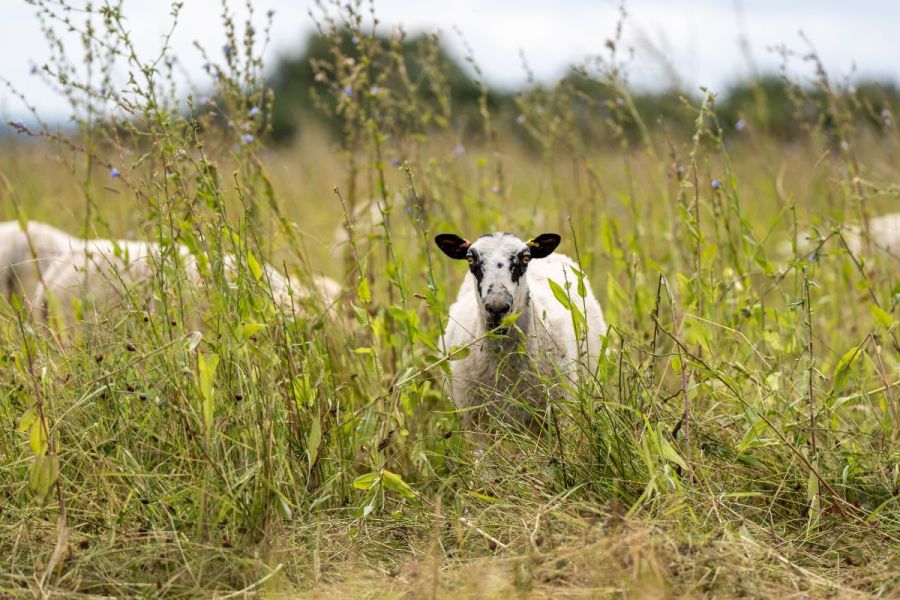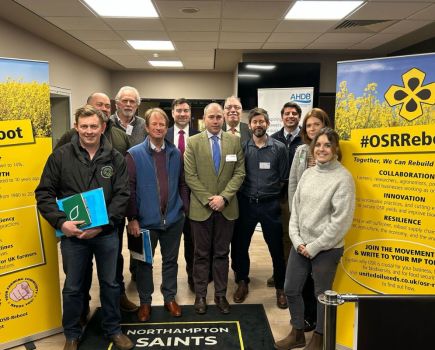For many this year, much rests on making a success of the Sustainable Farming Incentive, but what advice do biodiversity experts have regarding its management? CPM hosts BASF’s latest Real Results Roundtable to start the conversation.
“I walked into the field and it made my heart sing not just because of the skylark’s song, but because of the quality of the soil and crop.”
By Janine Adamson
This year, many growers have found themselves on board with the Sustainable Farming Incentive (SFI), a situation no doubt accelerated by a challenging 18-months where cropping rotations and management plans have been thrown into disarray.
And although growers are fully aware of the benefits of enhancing biodiversity, and in many cases already undertaking appropriate action, will their SFI activities deliver on government targets?
To help understand how to best manage and therefore enhance on-farm biodiversity, CPM brings together Northants grower and Project Fortress host, Andrew Pitts; wildlife farming consultant, Marek Nowakowski; research ecologist for the Game and Wildlife Conservation Trust, Dr Lucy Capstick; and BASF sustainability manager, Alice Johnston.
Having all worked together during the evolution of BASF’s Project Fortress at The Grange, the Roundtable discusses what they’ve learnt during the process while reflecting on the current direction and implementation of SFI.
Understanding ‘good’
The Roundtable began with Marek stating that when it comes to biodiversity in nature, the focus must be on quality rather than quantity. “Theologists use the word heterogeneity, which at a simplistic level means diversity.
“What this country has lost is not only habitat, but the diversity of habitats – which could continue to be the case when SFI is a three-year scheme rather than five-year. If you look at the actions being adopted, England is being rapidly covered by the same options and will end up with thousands of hectares of neutral-density grassland which won’t meet the government’s environmental target.
“Whereas focusing on quality and spreading habitats around the farm means insects and pollinators can reach a ‘petrol station’ which is the critical part.”
In agreement, Andrew explained his goal is to produce high value, clean seed crops in the centres of fields while maximising the environmental benefits which can be achieved around the outsides.
“And with environmental schemes, I’ve been through buying cheap and replacing them two years later. I’d rather choose quality options which you get greater financial benefit from in the long-term. It may be expensive to establish these types of crops, but you see a good variation of insects, birds and invertebrates because of that,” he said.
Furthermore, Andrew highlighted the importance of implementing best practice across the whole farming system by relaying his experience that morning. “I walked across a block of farmland that had been a second wheat seed crop before we autocast a stubble turnip mix for grazing by sheep.
“We then planted spring oats as a seed crop – which required no applied nitrogen because of the sheep manure – and produced 4t/ha at an incredibly low cost of production.
“This crop was a ‘low input spring cereal’ – AB14 – and the combination of these payments of £350/ha and the low input spend meant we’d a gross margin on that crop of more than £1200. Not only was it profitable, but the regular SFI payments help smooth the cash flow; this type of farming can pay.”
He says he then stripped the oats out and direct drilled straight into the stubble. “It looks fabulous. “The soil has changed colour during the 10 years of being direct drilled with a mixture of spring and winter crops plus grazing; it’s transformed.
“I walked into that and it made my heart sing not just because of the skylarks’ song, but because of the quality of the soil and crop. That’s what professional farming is all about – that’s the Holy Grail.”
Lucy added one of the first things the GWCT measured at The Grange was invertebrate abundance during the transition to direct drilling. “When we started monitoring, the plough was still being used in places and we noted on average there was an increase in the invertebrates in the direct drilled fields compared with those ploughed. There was also an increase in natural enemies and a reduction in pests in direct drilled fields compared with other cultivation types.
“In many ways, that’s indicative of good biodiversity – whether you can utilise beneficials as part of integrated pest management,” she said.
Managing abundance decline
With reports of a national decline in pollinators and beneficial insects this past year, the Roundtable discussed mitigation tactics.
To provide context, Lucy explained the wet spring and continued inclement weather has had an impact on pollinators, bumblebees especially.
“I repeated a bumblebee survey which was conducted in 2019 this year and there’s been an 70% decline across the same farms. As such, it’s becoming increasingly important to consider whether there are ways for us to buffer extreme weather conditions.”
Andrew raised this is where quality habitats come into their own. “That way nature is more resilient and can withstand these shocks in the same way soils with higher organic matter can better withstand drought. With more diversity in wildflowers, for example, there are more nectar sources for both long-tongued or short-tongued bees.”
Beyond the impact of environmental extremes, Marek pointed out the concept of natural decline. “Unless you’re rotating habitats over their appropriate period, they will decline, which is something we’re seeing at The Grange now.
“It’s not a criticism, but rather like a rotation in combinable crops, we should be creating a habitat rotation too, unless you’re on chalks in the Chiltern’s of course.”
Marek added that on heavy land, habitats will likely have to be relocated every 10 years to ensure insect and pollinator levels can be maintained.
Rewarding results
Continuing with the weather, having recently re-assessed what he perceives as a ‘normal’ autumn, Andrew questioned the current payment mechanism for SFI. “Now in our part of the world, a normal autumn is when you don’t get drilled up, so how do you reward a farmer for doing his best endeavours despite that?
“You could plant a high value wild bird seed or wildflower mix in the right conditions, at the right time of year and manage it correctly just for Mother Nature to release 12” of rain in 12 days and it’s washed away – that’s the problem.”
In response, Marek shared the ‘payment by results (PBR)’ experiment demonstrated that an alternative reward mechanism has the potential to work. “PBR is a model where farmers are paid based on the results of their actions, rather than for following specific methods and thanks to technology, it can easily be monitored.
“At the time, it was suggested that it wouldn’t work, even though it did, and now we have a system which encourages bums on seats rather than quality.”
Andrew said PBR would certainly pique his interest. “Our environmental crops are good because William (brother) and I value them. A first wheat is our most productive financially, but if we manage SFI well, that’s an effective break or rotational crop which has a value.
“If you can incentivise that value, farmers are very good at capturing premiums; essentially the environment has become a premium because it’s expensive to manage and requires investment of time. But PBR would yield massive results,” he commented.
Learning journey
As discussions turned to the learning process and how to encourage a change in mindset, Andrew shared that his journey to understanding biodiversity at a deeper level began in 2002 when the farm sold its dairy herd.
“William and I always had a passion for what’s alive in our surroundings, but it was selling the dairy herd that freed up management time and allowed us to start thinking. Whereas set aside was allowed around headlands, we realised we could do more than just let natural regen happen, instead, we could start planting wild bird seed or wildflower mixtures in small areas.
“And nature responds – it will always fill a void. If you put a food source or a habitat somewhere and predator control, nature will find it and take over.”
Having been introduced to Marek in 2017, Andrew said this was when his knowledge was taken to another level. “Much like overcoming a yield plateau, finding someone with even more passion than we had was the key.
“There’s tonnes of advice out there to be tapped into but the better the advice, the better the results you’ll achieve,” he stressed.
Conversely, according to Lucy, the GWCT has heard reports that information regarding the management of environmental schemes isn’t always tailored and as such, can prove a barrier to uptake. In response, Alice suggested there could be a current knowledge gap between academic work and farmer knowledge.
“A few years ago, individuals weren’t as clued up about soil health but since then there’s been a huge increase in knowledge; hopefully this will happen with biodiversity.
“The role of the agronomist is changing, more are focusing on the environment and becoming experts to ensure schemes like SFI are treated in the same way as crops. It’s about those areas of biodiversity being managed in a professional way,” she said.
Project Fortress
Reflecting on the learnings from Project Fortress, which has been underway since 2021 as a sustainable farming showcase, Alice says it’s become apparent that such approaches take time to establish.
“You don’t just plant it and then it’s job done. People, not necessarily farmers, think it takes a year and that’s it. But actually, you have to manage those actions, consider where they’re being established and ensure habitats are connected across the farm.
“Equally, being on farm and speaking to growers to share best practice knowledge is something we have to do more of, as well as helping wider society to better understand the gravity of the issue at hand,” she stressed.
Lucy agreed that improving biodiversity doesn’t happen overnight. “When monitoring the agro-floristry strips at Project Fortress, we noted a significant increase in invertebrate numbers as they’ve developed during the years. Not just general invertebrates, but the specific pest-predator relationships that we’re looking for such as parasitic wasps.
“That demonstrates the benefits you can achieve year-on-year even in challenging conditions.”
Reflecting on Lucy’s comment, Andrew raised that for him, the past season has highlighted how critical resilience is, across the whole of his business. “But you could also apply that to past six years – the new normal is huge weather events with hideous amounts of rainfall.
“We have to build more and more resilience, by increasing carbon in the soils, improving habitats for the environment, and creating a stronger balance sheet on the business, to try and de-risk.”
Expanding on Andrew’s point, Marek said connected in many ways to resilience, is quality. “If just 5% of farmland is put into quality refuge areas for wildlife, you have the potential to see a yield increase.
“Equally, there’s pride – I’m yet to meet a farmer who hasn’t created a habitat and been proud of it, just like Andrew at Project Fortress,” he concluded.
This article was taken from the latest issue of CPM. Read the article in full here.
For more articles like this, subscribe here.
Sign up for Crop Production Magazine’s FREE e-newsletter here.




